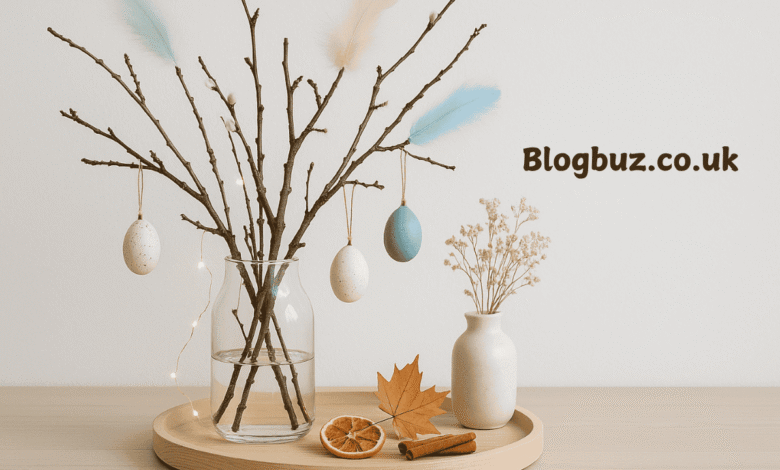Pyntekvister in Scandinavian Design: Simplicity Meets Elegance

The Scandinavian lifestyle has consistently emphasized striking a balance between nature and design. Among the many traditional decorative elements, pyntekvister stand out for their ability to bring natural elegance into homes and festive settings. Derived from the Norwegian and Danish words “pynte” (to decorate) and “kvister” (twigs or branches), pyntekvister literally means decorative twigs. These natural elements are more than just branches; they symbolize tradition, sustainability, and the art of simplicity. In this article, we’ll explore the origins, cultural significance, styling options, and modern uses of pyntekvister, showing why they have become a timeless choice in Scandinavian and global interior décor.
The Meaning and Origins of Pyntekvister
Pyntekvister trace their origins back to Scandinavian traditions, where nature played a central role in daily life and seasonal celebrations. Twigs and branches were often gathered from birch, willow, pine, or hazel trees to decorate homes during festivals.
Historically, pyntekvister were especially prominent during:
- Christmas: Bare branches were adorned with ornaments, candles, and later, fairy lights to symbolize light and renewal in the darkest season.
- Easter: Willow branches decorated with colorful feathers and eggs represented rebirth, fertility, and the arrival of spring.
- Midsummer and Harvest: Branches combined with flowers and herbs were used to celebrate abundance, fertility, and protection.
Thus, pyntekvister evolved not just as décor, but as cultural symbols reflecting renewal, resilience, and harmony with nature.
Pyntekvister in Scandinavian Design Philosophy
Scandinavian design is celebrated worldwide for its minimalism, functionality, and natural beauty. Pyntekvister perfectly embodies this philosophy. With their raw and organic look, these decorative branches reflect principles like:
- Simplicity: Clean lines and uncluttered spaces are enhanced with a few striking twigs arranged in a vase.
- Connection to Nature: By bringing outdoor elements inside, Pyntekvister fosters harmony between humans and the environment.
- Sustainability: Many branches are foraged naturally, making them eco-friendly and cost-effective.
- Versatility: Whether rustic farmhouse or sleek modern, pyntekvister adapt seamlessly to different interiors.
This is why pyntekvister are not just decorative—they are a lifestyle statement rooted in authenticity.
Seasonal Uses of Pyntekvister
One of the main reasons Pyntekvister remains timeless is its versatility, which allows it to adapt to all seasons. Each time of year offers new creative opportunities:
Spring and Easter
Freshly budding willow or birch branches decorated with feathers, painted eggs, or pastel ribbons are classic Easter pyntekvister. They symbolize new life and the awakening of nature.
Summer and Midsummer
For outdoor gatherings, pyntekvister decorated with flowers, herbs, and small lights can enhance garden tables and festive poles. They add a rustic, nature-inspired touch to summer décor.
Autumn and Harvest
Branches intertwined with dried leaves, berries, and pumpkins make warm and cozy fall decorations. Placed in entryways or on dining tables, autumn pyntekvister create a welcoming seasonal atmosphere.
Winter and Christmas
Bare twigs decorated with ornaments, baubles, artificial snow, or fairy lights bring festive elegance. Pine and spruce branches are often used to reflect tradition, while minimalist homes may prefer sleek painted branches in white or gold.
Styling Ideas with Pyntekvister
Pyntekvister can be styled in numerous ways, limited only by creativity. Here are some popular options:
- Vase Arrangements: Place bare or decorated branches in tall glass vases for a minimalist centerpiece.
- Wall Décor: Hang lightweight twigs horizontally and attach ornaments or seasonal elements to create a unique display.
- Table Centerpieces: Combine pyntekvister with candles, pinecones, or flowers for an elegant centerpiece for your dining table.
- Mantel Accents: Use twigs decorated with lights or garlands to highlight fireplaces during festive seasons.
- Wreaths and Garlands: Intertwine pyntekvister with greenery to create sustainable wreaths for doors or walls.
- DIY Projects: Spray paint branches in metallic hues or wrap them with fairy lights for a modern twist.
Materials Commonly Used for Pyntekvister
Not all twigs are created equal. Depending on the theme and season, different branches are used:
- Birch: Lightweight and flexible, great for spring.
- Willow: Known for its soft catkins, perfect for Easter.
- Hazel: Strong and curvy, often used for rustic effects.
- Pine and Spruce: Classic choices for Christmas and winter décor.
- Artificial Twigs: Painted or metallic versions are available for modern interiors, offering a versatile option.
By choosing the right material, pyntekvister can either add warmth or sleek sophistication to décor.
The Eco-Friendly Nature of Pyntekvister
In today’s world, where sustainability matters more than ever, Pyntekvister stands out as a natural and eco-conscious choice. They are often made from pruned or fallen branches, reducing waste and encouraging upcycling. Unlike synthetic decorations, they are biodegradable, renewable, and timeless.
For DIY enthusiasts, foraging for twigs locally not only saves money but also establishes a deeper connection to the environment. With minimal effort, Pyntekvister can be reused throughout the year by simply changing the decorative elements.
Symbolism and Emotional Connection of Pyntekvister
Beyond their visual appeal, pyntekvister hold symbolic and emotional meaning. They remind people of:
- Renewal: Branches budding with new life reflect fresh beginnings.
- Tradition: Passed down through generations, pyntekvister connect families to cultural heritage.
- Mindfulness: Decorating with natural materials promotes a sense of calm and simplicity.
- Cozy Living: In line with the Scandinavian concept of hygge, pyntekvister bring warmth and comfort into homes.
This symbolic power explains why they remain popular across centuries.
DIY Tips for Pyntekvister
Creating your own pyntekvister arrangement is a simple and rewarding experience. Here are some DIY tips:
- Choose Branches Carefully: Pick straight or curvy branches depending on the desired aesthetic.
- Clean and Dry: Remove excess bark, leaves, or dirt before styling.
- Paint or Decorate: Consider spray painting in white, gold, or black for a modern look; alternatively, leave the natural finish for a rustic charm.
- Add Seasonal Touches: Ornaments for Christmas, feathers for Easter, flowers for spring, or dried leaves for autumn.
- Use Sustainable Accessories: Opt for natural ribbons, biodegradable glitter, and eco-friendly paints.
Why Pyntekvister Remain Timeless
The appeal of pyntekvister lies in its simplicity, affordability, and versatility. They can transform ordinary spaces into stylish settings with minimal effort. Unlike artificial or trendy decorations, pyntekvister never go out of style because they draw inspiration directly from nature.
Whether displayed in a rustic farmhouse, a modern minimalist apartment, or a cozy cabin, pyntekvister adapt seamlessly. Their timeless quality assures they will continue to hold cultural and design significance in the future.
Conclusion on Pyntekvister
Pyntekvister are more than just decorative twigs—they are a fusion of tradition, nature, and creativity. Rooted in Scandinavian heritage, they bring sustainability, elegance, and emotional warmth to every season. From Easter feathers to Christmas lights, pyntekvister offer endless possibilities for both DIY enthusiasts and professional decorators.
You May Also Read: How Vintage Pewter Vases Are Making a Comeback in Modern Home Decor




